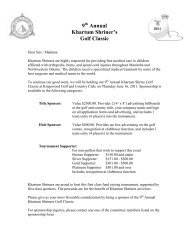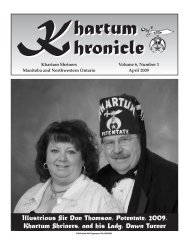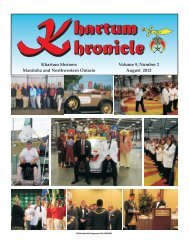K
Color Version - Khartum Shriners
Color Version - Khartum Shriners
You also want an ePaper? Increase the reach of your titles
YUMPU automatically turns print PDFs into web optimized ePapers that Google loves.
Hospital Report . . . continued from page 7<br />
and boat murals playing on the Atlantic<br />
theme and so on.<br />
If you know of any child under the age<br />
of eighteen who may be a suitable candidate<br />
for our Shrine Hospital and the care<br />
these facilities provide, please contact me. I<br />
can be reached at the Shrine office most<br />
Mondays to Fridays between 9:00 A.M. and<br />
noon at 204-925-1439 or on my cellular<br />
phone at 204-781-6503.<br />
Researchers at Shriners Hospitals for<br />
Children Canada discovered the cause of<br />
the debilitating bone disease known as<br />
MDMHB (metaphyseal dysplasia with<br />
maxillary hypoplasia and brachydactyly).<br />
(Montreal, Canada) Shriners Hospitals for<br />
Children® — Canada is the first, worldwide,<br />
to identify the genetic defect underlying<br />
a painful bone disease that causes an<br />
unusual series of symptoms including<br />
severe tooth decay, osteoporosis, and spinal<br />
fractures in teenagers. Led by Frank<br />
Rauch, M. D., a pediatrician, and Pierre<br />
Moffatt, Ph. D., a basic scientist at Shriners<br />
Hospitals for Children Canada, the team<br />
discovered that a part of the RUNX2 gene<br />
was duplicated and therefore caused<br />
MDMHB. They were able to link the<br />
unusual series of symptoms observed in<br />
patients to the changes observed in the<br />
RUNX2 gene, essential for creating boneforming<br />
cells. In doing so, they established<br />
that these changes in the RUNX2 gene<br />
result in disordered bone cell production,<br />
the cause of MDMHB. The discovery was<br />
published in the American Journal of<br />
Human Genetics this month.<br />
What does this disease look like?<br />
MDMHB was first named and described<br />
more than thirty years ago by the Montreal<br />
Children’s Hospital’s Fahed Halal, M. D. In<br />
1982, he published his findings, which<br />
included the physical characteristics of<br />
twelve children and their family members<br />
who all had the same unusual series of<br />
symptoms: fractures of the spinal column<br />
(not due to accident), low bone density,<br />
crumbling teeth, and large collarbones.<br />
Bones in the arms, legs, and pelvis also<br />
looked unusually large on X-rays and<br />
sometimes scoliosis was present. The first<br />
patients to come to Shriners Hospitals for<br />
Children Canada with this disease were<br />
seen in 1992 by pediatrician Gilles Chabot,<br />
M. D., who referred them to metabolic bone<br />
disease expert Francis Glorieux, M. D., Ph. D.<br />
The outcome of this disease for<br />
patients is a life in pain. Their teeth break<br />
easily and can be so painful that they have<br />
to have them pulled by the age of twenty.<br />
As these patients grow, many have breaks<br />
in their backbones, similar to what occurs<br />
in elderly people with osteoporosis.<br />
Research to Find<br />
the Cause of MDMHB<br />
In 2003, Dr. Rauch saw a new teenage<br />
patient in the Metabolic Bone Clinic at<br />
Shriners Hospitals for Children Canada.<br />
The patient complained of back pain and<br />
had the physical characteristics that<br />
matched the already described MDMHB.<br />
He went on to examine relatives and found<br />
that three other teens and two adults were<br />
affected in the same way.<br />
“We obtained X-rays, performed bone<br />
density tests, and took samples for DNA<br />
analysis,” says Dr. Rauch. “However, at<br />
that time the technology did not exist to<br />
identify the disease-causing gene in such a<br />
-8-<br />
group. But two years ago, a<br />
consortium was set up for finding<br />
rare disease genes in Canada.<br />
With their support, we<br />
could get the samples analyzed<br />
at the Genome Centres<br />
in Montreal and Toronto, and<br />
we detected a problem in the<br />
RUNX2 gene in all affected<br />
family members.”<br />
With genetic results in<br />
hand, Dr. Rauch asked for Dr.<br />
Moffatt’s help to uncover the<br />
mystery behind MDMHB.<br />
Why was this extra piece of<br />
gene causing these physical<br />
symptoms? Dr. Moffatt found<br />
that the genetic change leads<br />
to a more active and higher<br />
amount of RUNX2 protein<br />
inside cells. Why this causes<br />
osteoporosis in teenagers is<br />
not yet clear.<br />
Understanding MDMHB<br />
Currently, the bonebuilding<br />
treatment pioneered<br />
at Shriners Hospitals for Children<br />
Canada for patients with<br />
osteogenesis imperfecta (brittle<br />
bone disease) is also being<br />
used for MDMHB patients. “It<br />
increases bone density and<br />
minimizes bone pain,” says<br />
Dr. Rauch, “but it does not<br />
directly affect the underlying<br />
problem in this disease.”<br />
“Now that we know the<br />
cause, we can identify patients<br />
FREE HOME EVALUATION CERTIFICATE<br />
Find out what your home is worth!<br />
Dependable Service using my Successful Time-Tested<br />
Marketing System to get you more money for your home!<br />
You can earn up to<br />
1500 AIRMILES® Reward Miles<br />
when you BUY or SELL your home through me!<br />
GERRY KRAWCHUK, REALTOR<br />
Century 21 Advanced Realty<br />
925-7999<br />
. . continued on page 9<br />
36 Years of<br />
Award Winning Service<br />
If your property is currently listed with a real estate broker, please disregard. It is not our intention to select the offerings of other real estate brokers. Each office is independently owned and operated.












